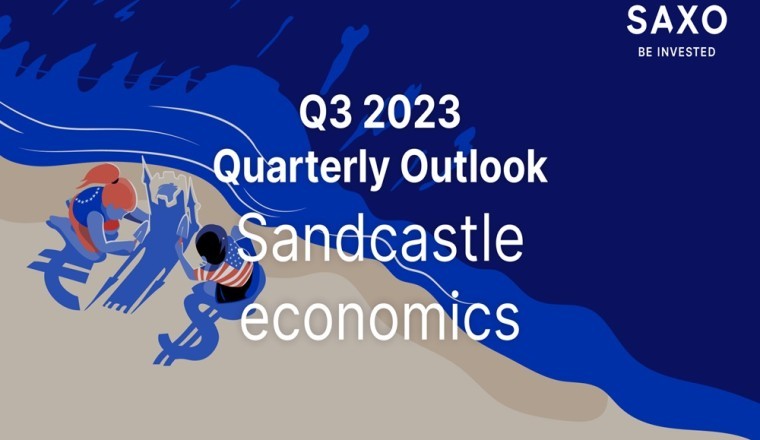As economic growth remains robust, driven by sectors like defence, AI, and obesity drug manufacturing, Saxo's strategy team warns of the fragility of this "sandcastle economy" in their quarterly outlook for Q3. Although their perspective for the short term is neutral, this outlook explores the underlying threats of unsustainable US fiscal spending, geopolitical risks, and demographic trends that could destabilise the current economic momentum in the longer term.
In his macro note, “Sandcastle economics,” Peter Garnry, Saxo's chief investment strategist, emphasises the precarious nature of our current economic growth. He states, "Economic growth will remain stable, but down the road, several factors can destroy our sandcastle economy."
Garnry explores the concept of a "two-lane economy," where thriving sectors contrast struggling ones. This disparity complicates monetary policy, as aiding weaker sectors could prolong inflation, increasing economic costs. Inflation remains persistently high, prompting cautiousness from the Fed and delaying rate cuts until a significant economic slowdown is observed.
"The Q3 outlook reveals a complex financial landscape with significant implications for the Middle East. The region, heavily influenced by global economic trends, must navigate the dual challenges of persistent inflation and geopolitical uncertainties, said Damian Hitchen, CEO of Saxo Bank MENA. Robust demand in key sectors such as energy and agriculture presents opportunities, but the underlying fragility of the global economy necessitates a cautious approach. The Middle East needs to stay attuned to these dynamics to mitigate risks and leverage growth prospects effectively.”
Saxo’s main calls for Q3 2024:
Commodities: Energy and grains in focus as metals pause
Robust demand and production challenges are expected to continue supporting commodities. While the metal sector, including gold and copper, takes a breather after reaching record highs, energy and grains are poised for growth. Additionally, Ole Hansen, Saxo’s head of commodity strategy, states that crude oil is “supported by OPEC's 'line in the sand' price and strong summer demand towards mobility and cooling."
Despite a second-quarter setback in energy due to a deflated geopolitical risk premium, metals remain strong. However, Ole Hansen notes that “industrial metals require a recovery in Chinese demand to justify higher prices at this stage." The energy sector anticipates robust demand in the third quarter from increased mobility and cooling needs amid seasonal heatwaves.
In summary, while metals consolidate, energy and agriculture sectors are expected to be the key drivers of growth in the coming quarter, supported by OPEC production restraints and weather-driven supply concerns in grains.
Equities: Are we blowing bubbles again?
As the third quarter of 2024 begins, the current market rally shows signs reminiscent of 2021, driven by speculative tech growth, crypto, meme stocks, and high US equity valuations, "which is higher than we saw during the dot-com bubble," notes Peter Garnry, chief investment strategist. Extreme index concentration is evident, with the 10 largest stocks comprising 35% of the S&P 500 Index.
Despite the exuberance in US markets, we remain overweight European equities. We "believe European equities will be repriced higher relative to other markets on the ECB rate cut in June and a growth rebound in the third quarter."
While the US market may appear stretched, European equities and sectors tied to electrification are interesting areas to watch.
Fixed income: What to do until inflation stabilises
As US and European sovereign bond yields are expected to remain range-bound during the third quarter, the uncertain inflation outlook persists despite less aggressive monetary policies. Saxo’s head of fixed income strategy, Althea Spinozzi, highlights this in her outlook: "US Treasury yields are expected to remain elevated until inflation trends decisively return towards the 2% target." Spinozzi notes that the divergence between US and European rates “will keep bond volatility elevated, prompting us to overweight high-quality credit and short-term duration."
Investment-grade corporate bonds are "likely to remain well-bid as direction on inflation remains uncertain." High-yield bonds, acting as a hedge against inflation, are also expected to stay supported despite tight spreads.
In this environment, it makes sense to maintain a cautious stance and limit duration exposure. Focus on quality and maturity up to five years while being cautious with longer durations. Long-term rates remain vulnerable to inflation trends and potential rebounds in the term premium.
FX: Risk-on currencies to surge against havens
A bearish USD trend could extend into Q3 if US economic weakness broadens, although valuation and safe-haven appeal limit the downside. High-beta currencies like AUD and NZD are well-positioned to outperform due to lagging central bank easing cycles and a stabilising Chinese economy.
However, Charu Chanana, head of FX strategy, mentions that "low-yielding currencies such as JPY and CHF are likely to underperform in a dollar-bear world due to negative carry."
Emerging market (EM) carry trades could remain popular, but tighter risk management is necessary as yield gaps narrow. While the USD may face downside risks, selective high-beta currencies and tactical EM carry trades present potential opportunities in the evolving FX landscape.

